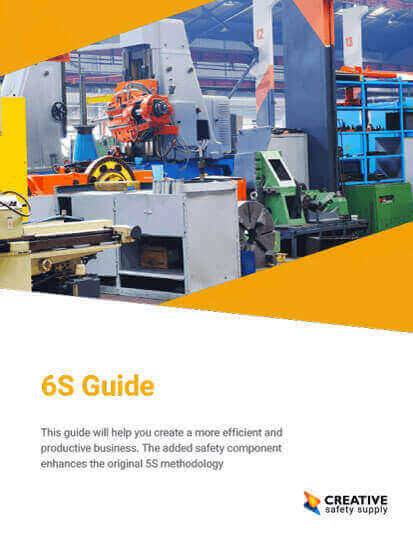
The principles of 6S stand as pillars of organizational excellence, reshaping workspaces into efficient, safe, and well-organized environments. It's one thing to know the principles and rules of 6S, but it's also important to see how they could be applied in the real world. As organizations across various industries embrace Lean methodologies, the question arises: What are some examples of 6S in the real world? In this comprehensive exploration, we delve into real-world instances of 6S implementations, unveiling how different organizations have leveraged the power of 6S to enhance efficiency, reduce waste, and prioritize employee safety. In each example, there will be specifics on each aspect of 6S, including safety and how it works.
Example 1: Manufacturing Facility Optimization
In a bustling manufacturing facility, 6S principles have been seamlessly integrated to optimize operations.
- The "Sort" step involves scrutinizing the tools, materials, and equipment used in the production process. By identifying and eliminating unnecessary items, the facility reduces clutter, minimizes time wasted searching for tools, and prevents potential tripping hazards.
- "Set in Order" transforms the facility's layout. Workstations are reconfigured to ensure that essential tools are easily accessible, minimizing unnecessary movements. This reorganization leads to a significant reduction in production delays and an overall increase in efficiency.
- The "Shine" step translates to regular cleaning and maintenance. Workspaces are kept immaculate, preventing debris accumulation and ensuring the longevity of equipment. A clean environment not only improves morale but also upholds safety standards.
- "Standardize" brings forth standardized work procedures. The production line adheres to uniform processes, eliminating variations that could lead to errors or accidents. By maintaining consistency, the facility experiences a reduction in defects and an increase in product quality.
- "Sustain" is upheld through regular audits and employee engagement. Periodic checks ensure that the 6S practices remain intact. Employees actively participate in maintaining standards, fostering a culture of collective responsibility for the organization's success.
- "Safety" is an overarching principle, woven into every step of this example. By identifying potential hazards and implementing safety measures, the facility ensures the well-being of its employees. This commitment to safety not only prevents accidents but also instills a sense of security among the workforce.
Example 2: Healthcare Environment Enhancement
In the healthcare sector, a hospital embraced 6S principles to optimize patient care and safety.
- "Sort" translates to a meticulous assessment of medical supplies. Outdated or unused items are removed, freeing up space and reducing the risk of errors caused by using expired supplies.
- "Set in Order" leads to strategically organized medical carts. Essential supplies are arranged in a logical sequence, ensuring that medical staff can quickly access what they need during emergencies. This arrangement minimizes the time spent searching for supplies and bolsters patient care.
- The "Shine" principle results in impeccable hygiene. Patient rooms and common areas are consistently cleaned, reducing the risk of infections and creating a comforting atmosphere for patients and their families.
- "Standardize" introduces protocols for patient care procedures. This standardization not only enhances patient safety by minimizing errors but also facilitates smoother transitions between shifts and medical staff.
- "Sustain" is embraced by involving hospital staff in regular training and audits. The culture of continuous improvement empowers employees to identify potential safety hazards and propose solutions.
- "Safety" remains a paramount concern throughout every aspect of the hospital's 6S implementation. From infection control measures to ensuring medical equipment functionality, the hospital prioritizes patient and staff safety at every step.
Example 3: Office Space Organization
Even in office settings, 6S principles find relevance. In a corporate office,
- "Sort" manifests as decluttering workspaces. Unnecessary papers, files, and equipment are eliminated, leading to increased desk space and reduced visual distractions.
- "Set in Order" transforms the organization of documents and supplies. Each item has a designated location, preventing employees from wasting time searching for needed materials. This organization streamlines tasks and enhances productivity.
- "Shine" leads to the regular cleaning of workspaces. Dust-free surfaces and tidy work areas not only improve morale but also eliminate potential allergens, contributing to employee well-being.
- "Standardize" establishes consistent filing and organization protocols. Employees follow a unified system for document management, reducing the likelihood of misplaced or lost information.
- "Sustain" is fostered through periodic audits and shared responsibility. Employees hold each other accountable for maintaining organized workspaces, perpetuating the 6S practices.
- "Safety" in the office context encompasses ergonomic considerations, fire safety measures, and general well-being. The office space is designed with safety in mind, ensuring that employees can work comfortably and without unnecessary risks.
These real-world examples underscore the versatility and power of 6S principles across diverse industries. Whether in manufacturing, healthcare, or corporate settings, 6S serves as a guiding light that enhances efficiency, reduces waste, and prioritizes employee safety. Through the journey of "Sort, Set in Order, Shine, Standardize, Sustain, and Safety," organizations unleash the potential of their workforce while creating environments that exemplify Lean excellence. The practical applications of 6S demonstrate that its impact transcends industries and speaks to the universal pursuit of operational excellence and workplace well-being.
Similar Questions
- Is 6S Suitable for Non-Manufacturing Environments?
- What is the Definition of 6S?
- What are the Rules of 6S Safety?
- How Do I Use 6S for Safety?
- Why should you implement 6S in your workplace?
- Why is 6S important?
- How does employee engagement affect 6S implementation?
- What are some examples of the Differences between 5S and 6S?
- How Does 6S Safety Work?

